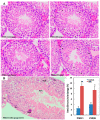Adverse Effects of Prenatal Exposure to Oxidized Black Carbon Particles on the Reproductive System of Male Mice
- PMID: 37505521
- PMCID: PMC10385084
- DOI: 10.3390/toxics11070556
Adverse Effects of Prenatal Exposure to Oxidized Black Carbon Particles on the Reproductive System of Male Mice
Abstract
Ambient black carbon (BC), a main constituent of atmospheric particulate matter (PM), is a primary particle that is mainly generated by the incomplete combustion of fossil fuel and biomass burning. BC has been identified as a potential health risk via exposure. However, the adverse effects of exposure to BC on the male reproductive system remain unclear. In the present study, we explored the effects of maternal exposure to oxidized black carbon (OBC) during pregnancy on testicular development and steroid synthesis in male offspring. Pregnant mice were exposed to OBC (467 μg/kg BW) or nanopure water (as control) by intratracheal instillation from gestation day (GD) 4 to GD 16.5 (every other day). We examined the testicular histology, daily sperm production, serum testosterone, and mRNA expression of hormone synthesis process-related factors of male offspring at postnatal day (PND) 35 and PND 84. Histological examinations exhibited abnormal seminiferous tubules with degenerative changes and low cellular adhesion in testes of OBC-exposed mice at PND 35 and PND 84. Consistent with the decrease in daily sperm production, the serum testosterone level of male offspring of OBC-exposed mice also decreased significantly. Correspondingly, mRNA expression levels of hormone-synthesis-related genes (i.e., StAR, P450scc, P450c17, and 17β-HSD) were markedly down-regulated in male offspring of PND 35 and PND 84, respectively. In brief, these results suggest that prenatal exposure has detrimental effects on mouse spermatogenesis in adult offspring.
Keywords: atmospheric particulate matter; in utero exposure; male offspring; oxidized black carbon; spermatogenesis; steroidogenesis.
Conflict of interest statement
The authors declare no conflict of interest.
Figures




References
-
- Qi L., Wang S. Fossil fuel combustion and biomass burning sources of global black carbon from GEOS-Chem simulation and carbon isotope measurements. Atmos. Chem. Phys. 2019;19:11545–11557. doi: 10.5194/acp-19-11545-2019. - DOI
Grants and funding
LinkOut - more resources
Full Text Sources

